Dec 3, 2020
Flows: 95 cfs
Water Temp: 40F @ 9:30a.
Water clarity: 3’
Air Temp: 27 @ 9a, 45 @ 4p
Hatches: BWOs 11a to 1:30p. Midges 3p to 4p (time I left).
Flies: #18 Red Copper John, #24 Mercury Red Zebra Midge, #24 Jujubee Midge, #18 BH Pheasant Tail, #20 Red Pheasant Tail, #24 Mercury Beatis, #22 Parachute BWO, #20 Cripple, #22 Improved Sparkle Dun BWO.
Top producers: Red Zebra, Red Pheasant Tail, Mercury Beatis, Parachute BWO, Cripple.
Looking downstream from the Blue Heron Hole.
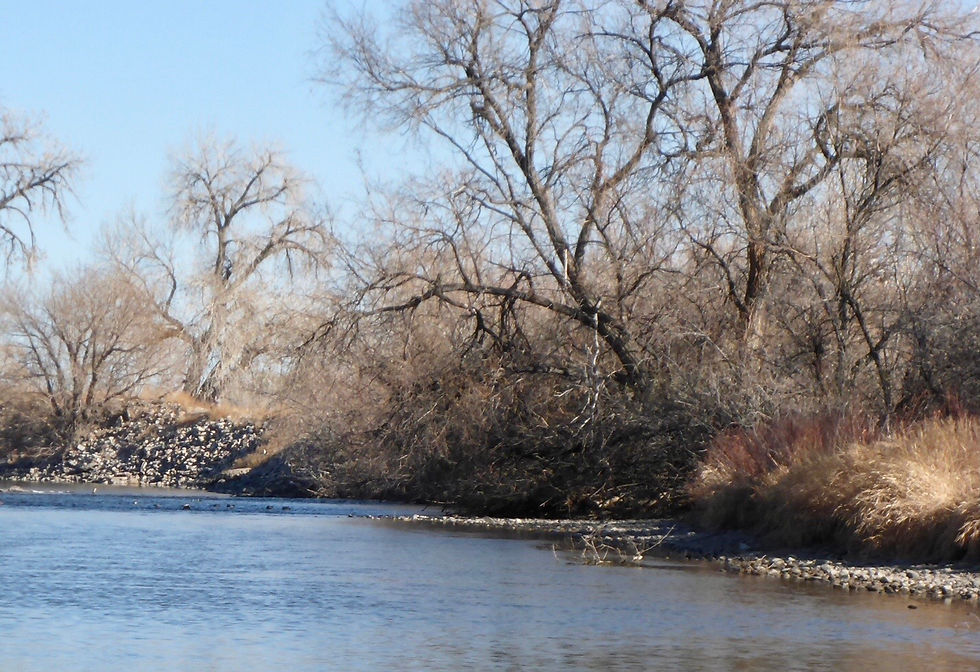
It was a sketchy week weather wise in Colorado. It wasn’t looking promising for fishing but as the week went on the forecast improved. If fact they were predicting a high of 50F in Pueblo yesterday – pretty balmy for a December outing! Needless to say, I took advantage and squeezed in a solo trip to the Pueblo Tailwater yesterday.
The Nature Center parking lot was empty when I arrived at 9:15a. A welcome surprise. The colder weather earlier in the week must have kept the fair weather anglers at home. Good by me. In fact when got to the river I had the whole place to myself! You have to realize this section of the river covers about 1 mile – and it’s a big river! No other fishermen within sight all morning. It was a little eerie at first – but I quickly got used to it!
A view across the Diver Hole.
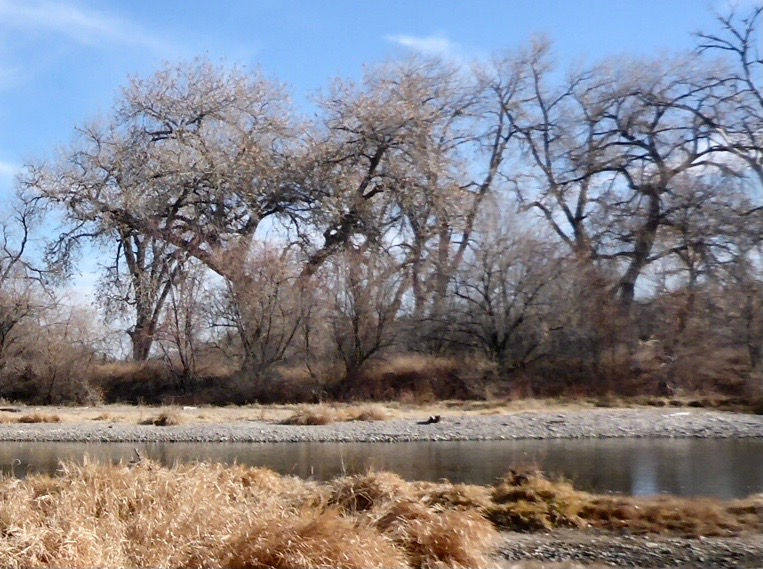
The fishing started out slow though. The water was a little off color making sigh fishing very difficult. I started out at The Diver Hole. Even though I couldn’t see any fish – I new from past experience that they liked to hang out there. On my second cast I had a fish on. Hooked him up on the right side of the 1st boulder leading into the hole – but he quickly got off. Not sure what happened there, but I was encouraged.
It kept me in the hole for longer than I would have liked. My thinking was that there had to be more fish in there. So I covered the entire run and hole over and back several times. Making adjustments each time to account for depth. But I had no more takers and finally decided to move on.
Next, I worked the run leading up to the Plunge Hole #2. This area usually has nice fish feeding in the braids that are created by the boulders and substructure along the run. But I couldn’t see any fish and had no takers. This included the Plunge Hole. I was thinking “I’ve got to find some fish”!
Per my usual sequence – I then moved into the Nature Center West Hole. On past trips, I’ve found some nice fish feeding behind the weir and along the seam it creates. A Dry/Dropper set-up works best there, but I left my nymphing rig as it was. After covering this section without any hits, I moved on. Next stop was the Flag Pole Hole. As I was wading out of the hole – I spooked a nice trout that was feeding in shallow water at the end of the seam. Perfect for a Dry/Dropper set-up!! Oh well….
Once you get out of the river there’s a walkway that leads to the Flag Pole Hole and a lot of slow water along the way. Occasionally there are fish rising at the very end of the run that leads into the slow water. I’ve named this The Blue Heron Hole – named so because of the Blue Heron that like to hang out there. If any fish are rising there, you can see them from the walkway. And as I walked along there, I could see a couple of fish – rising to slurp adult flies. I took note of that and planned to check back there later in the day.
When Brian and I first started fishing the Pueblo Tailwater, we didn’t know that someone had already named the Flagpole Hole. So I called it Brian’s Run because he found this gem on our first trip. It begins with fast riffles leading into a fairly deep run that drops off into a deep pool. The pool tails out into slower water that is shallow along the bank and has deep pockets and pools towards the middle of the river. This then drains into the Blue Heron Hole. All told, it’s probably 1/8 of a mile long.
Looking into the start of the Flagpole Hole. (The fast riffles are on the left).
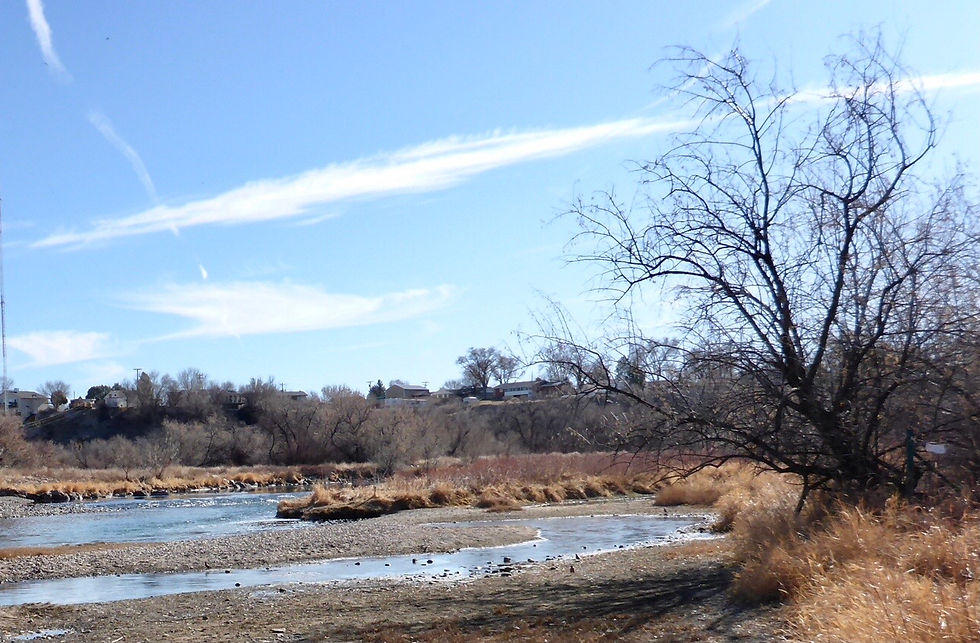
Both Brian and I have caught fish all the way from the fast riffles to the start to the Blue Heron Hole. And it didn’t disappoint - I finally found some fish!
The Blue Wing Olives started to hatch when I left the Nature Center West Hole leading me to change my target fly to a Mercury Baetis before fishing this section. The first fish on was a 14” rainbow that I got just below the fast riffles. He broke free just before the net, but I could see that he took the Mercury Red Zebra Midge. Then I got a nice 16” rainbow in the deep pool. This one took the Mercury Beatis, which is becoming one of my top producers! I had another nice one on in the deep pool. He hit on the rise but was able to shake loose after a brief battle.
Here's a close up showing the Mercury Beatis.

It was about 12:30p and time for a late lunch. That’s when I saw the first fisherman of the day. And I only saw four others the rest of the day. During lunch I was thinking of bringing my dry fly rig with me for the afternoon. In fact I was convinced that I would. Then as I was getting ready to leave, I decided against it. I was planning to start at the Flagpole Hole, then work upstream. This would require covering a lot of ground – or river – and I didn’t want to have to be concerned about constantly going back to get my rig. And as disappointing as it is - people have been know to take a rig left along the bank here!
So I set out with only one rod – which I had rigged for nymphs. As I walked along the path toward the Flagpole Hole – I spotted a pod of fish rising at the Blue Heron Hole. Wouldn’t you know it! I couldn’t pass up this opportunity. If it was only one or two fish rising – then maybe I could have - but not a pod of them.
I could still see BWOs hatching, so I first tied on a Parachute BWO. Then I decided to try a Cripple for my target fly. Not sure why, but I wanted to give it a shot. I could see nice size fish feeding in front of me closer in toward the shore where the water was really slow. I tried for them 1st – but as they slowly rose and inspected my flies - they refused. I then casted into a seam of faster water and immediately had a fish take the Parachute BWO. It was about a 6” rainbow! I was thinking to myself that the big fish were too smart – staying in the slow water where they had time to really inspect the flies. While the smaller fish were pushed out further into the faster water where they didn’t have the time to do the same.
Just then a nose rose out of the water and took one of my flies. It happened in slow motion. As the fish went back under the water – I thought to myself that I better set the hook. And I did. I could tell when she came up to take my fly, that it was a pretty big fish – but I was surprised that she was 18 inches. And she put up quite a fight – going back and forth through the hole where all the fish were feeding. I wanted to keep her out of there, but couldn’t. She was beautiful but an unusual rainbow from a coloration perspective, very light with pink markings rather than reddish ones that are more typical.
Notice the unique coloring on this 18" female rainbow.
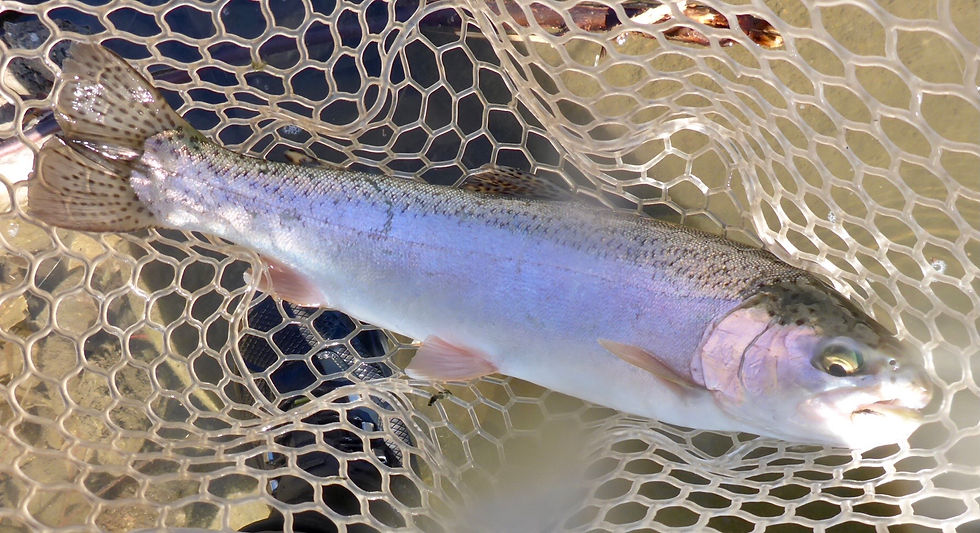
All the runs that she took right through the hole must have spooked the other fish. After releasing her, they seemed to disappear. I stood there for awhile watching and was getting ready to leave when I spotted another fish rising a bit further upstream. He hit on my second cast. He swam towards me and I thought I was able to maintain good tension on the line as he did. But I guess I didn’t as he was able to break free.
In the middle of all this – there was a healthy hatch taking place and I wasn’t sure what they were. It looked like multiple types of flies were hatching. Some were small and others larger. I was pretty certain that some were beatis by they way they looked in flight. So I caught a couple. One was a beatis – black head, olive body. The other one, I wasn’t sure and I’m still not. It had a red body and at first I thought maybe a Red Quill which is a type of beatis. But when I caught him, I damaged his wings and I didn’t see any tails - these are two indicators to help ID the species. Later, after inspecting the picture I took – I still can’t ID it.
Upon a closer look - this may be some type of midge - but not sure. Will take some research to find out.
Latest update: After checking with a friend of mine - Max Pavel - who is a guide and professional fly tier - he concurred that this is a midge. Most likely a "winter midge".

After hooking up that last fish – everything dried up. Save for a couple of very picky trout. I tried for them for awhile – even changing my target fly to a Sparkle Dun BWO – but they wouldn’t take. So I left.
Next stop was the Flagpole Hole. I finally made it back – but a little later than planned. Now I had to switch back to nymphs, changing them to imitate beatis. Attempting to imitate the red fly I caught a just a bit ago, I decided to use reddish colored beatis flies for the 1st two. Then I tied on a Mercury Beatis as the target fly to imitate the BWO that I also caught. On my first cast to the far side of the run where it drains into the deep water – I had a fish on.
This is the 18" rainbow. You can get a feel for his size in this shot.

It was a nice one for sure. He took out a bunch of line and went into the fast water. I couldn’t move downstream with him because I was standing in front of a submerged beaver hut which was dug out and deep. And I couldn’t get out of the water because the bank was too high to step up. I thought I was going to lose this one for sure. He came up in the fast water and was shaking his head. Not a good place to fight a fish! But I was able to lead him into the slower water near the bank and bring him in! He was a healthy 18” rainbow in the 3 pound range. He took – what else – the Mercury Beatis.
Here's another view. A very healthy 18" rainbow.
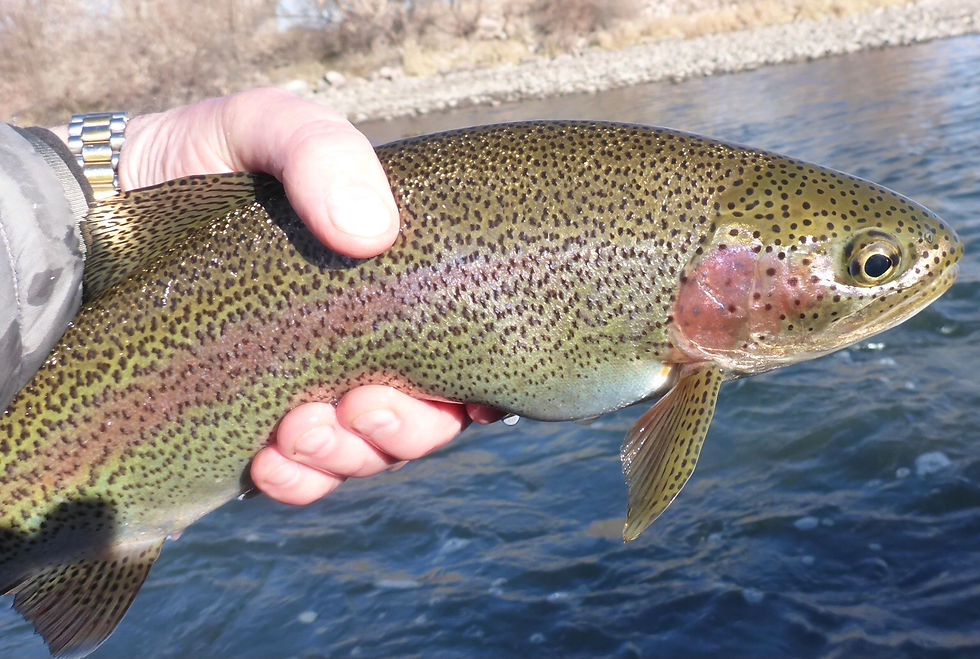
I hooked up and landed a few more in the deep pool. A couple of nice ones - 14" to 16" -and a few smaller ones - in the 8" to 12" range. They were fooled by the Mercury Beatis and the Red Pheasant Tail.
A unique shot of one of the rainbows.
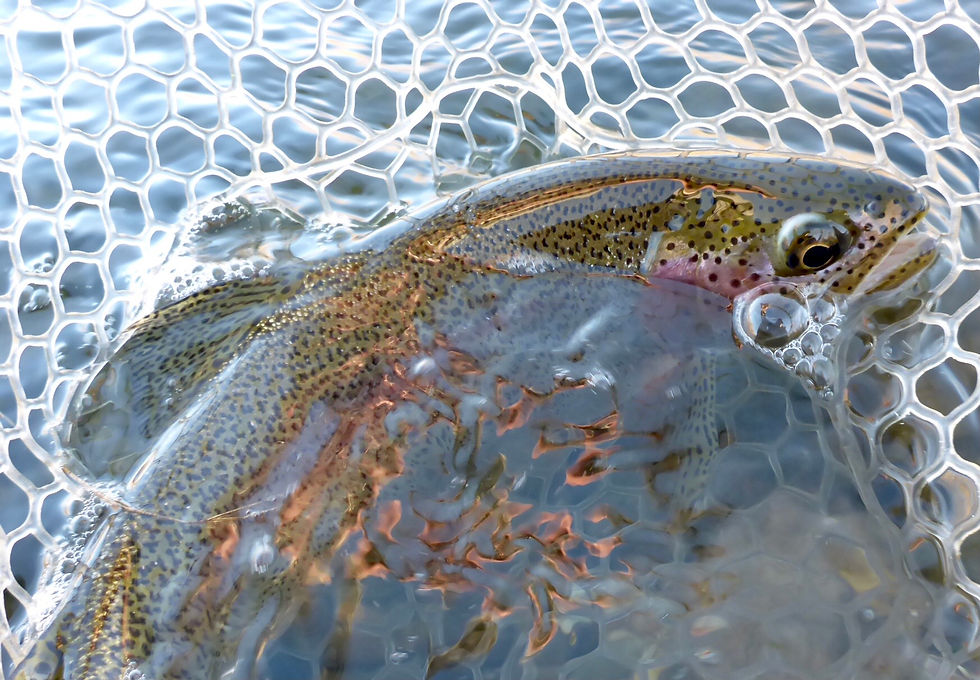
A 16" brightly colored - healthy - female rainbow.

I was in the hole about 1 1/2 hours and another pretty thick hatch was in progress and again I wasn’t sure what they were. At first they looked like beatis but their flight was off. So I caught a few and low and behold they were midges. It was about 3:30p and the afternoon midge hatch was on. I only had about a half hour left including a 15 minute walk to the car. So I called it a day – just explored the area a bit before I left.
The afternoon midge hatch.
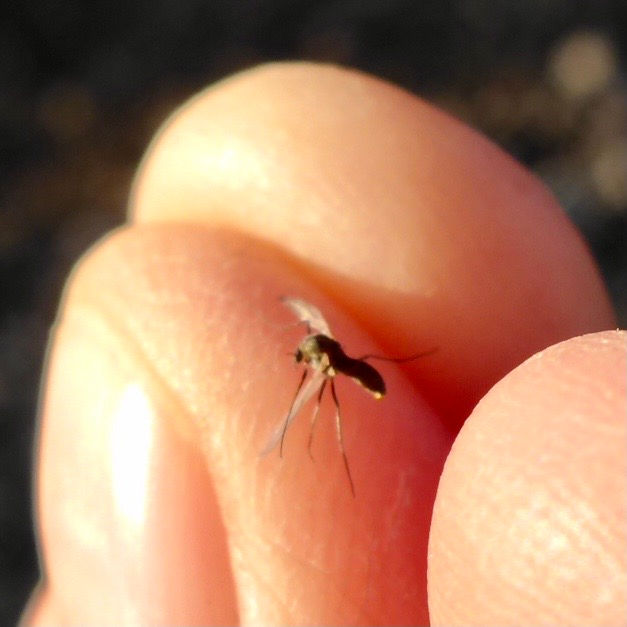
Just what the doctor ordered. Out of doors on a beautiful early December day. On the river. The whole place to myself ---- and hungry trout.
Comments